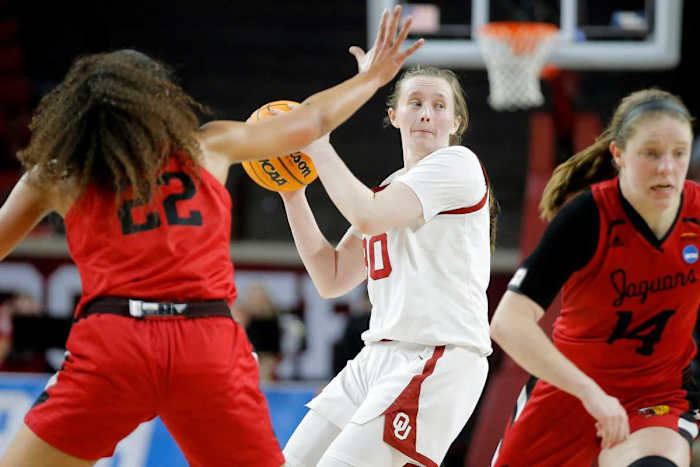COLUMN: Oklahoma's 'Super Six' Challenges in 2021 Pushed This Year's Team to New Heights
NORMAN — Sometimes the only way forward is through.
The Oklahoma women’s basketball team fought though in 2021, and now they’re moving forward in 2022.
For large portions of last season, the Sooners played games with just six players — five starters and one substitute. Now-retired coach Sherri Coale lovingly referred to her troops as her “Super Six,” and they overcame the inherent adversities by finishing Coale’s final season with a 12-12 record.
Injuries, COVID, more injuries — those Sooners never knew who would be available for games.
READ MORE
“I don't know,” said senior Madi Williams, “it was one of the funnest seasons I've had here, just to be able to go out and not know what was going on, how many people we would have, who we would have, and just to go and hoop. That's all we were worried about.”
“I think the phenomenal thing about this group,” said new coach Jennie Baranczyk, “is they're proud of that. There weren't the horror stories.”
Now calloused by those challenges, hardened, this Sooner squad has shocked almost everyone by winning 25 games, earning a 4-seed and two postseason home games, and hurling themselves into the second round of the NCAA Tournament with a 78-72 first-round victory over IUPUI.
OU plays 5-seed Notre Dame on Monday night at Lloyd Noble Center, with a Sweet Sixteen trip on the line.
The foundation laid by last year’s “Super Six” continues to produce dividends.
“It definitely put a sense of the fact that we could hang with people with six players,” Williams said Sunday. “And those six players were — you never knew what positions you were going to have on the floor.”
Williams is a two-time All-Big 12 performer, but she had to carry an even bigger load throughout her junior year, when Coale and her squad couldn’t really draw up a standard game plan due to a stark lack of personnel on a nightly basis.
“A lot of times it was all five guards and we just had to figure it out,” Williams said, “and that just showed us that we could face adversity and we could push through.”
Senior guard Taylor Robertson said that all-guard lineup did make for some tough defensive challenges — such as guarding the opponents’ post players — but opened up avenues of creativity on offense.
“They might be bigger on the offensive end,” Roberson said, “but when we play offense, who are they going to guard? How are they going to guard? Because they're going to have to come out on the perimeter, we'll just be able to shoot over them.”
When, How to Watch
- No. 4 Oklahoma vs. No. 5 Notre Dame, Monday, 5 p.m., ESPN2
Divider
(Variant 1)
Robertson got a question in Sunday’s press conference about the quick turnaround between Saturday’s late win over IUPUI — the Sooners didn’t leave the arena until after midnight — and Monday’s 5 p.m. game against the Fighting Irish. Robertson applauded her squad as “such a team with great depth.”
There were no such sentiments last year. Not once.
“Being able to find different ways last year with six, I think that has helped this year because the six or seven or eight that were available last year now are back, and that depth and experience has definitely helped in all ways this year.”
Baranczyk said players noticed the difference down the February stretch this year when they had to practice. Many times last year, they didn’t have enough players for a full practice, or they were so worn down by the extended game minutes, Coale wisely gave them more time off.
That OU has won 10 games this season by two possessions or less, including two overtimes and three on buzzer-beaters, reflects on the team’s toughness, focus and single-mindedness that was instilled by being a part of the “Super Six” of 2021.
“I think the stories that they talk about, being able to do that, again, goes into the resiliency, goes into — nothing is too big or too small for this team,” Baranczyk said. “Especially at those end-of-game situations, I think living where they can really trust each other — because you have to, but I think you can definitely see that that has propelled them.
“I think most teams that went through last year in terms of — it wasn't that easy living in the bubble — right? — with your team. And I think some teams separated, and some teams really connected. And I think this is a team that really connected, and you can see it this year.”


